I love Harbor Freight. I find myself wandering the isle even when I don’t have anything in mind to purchase…has window-shopping is a real thing!
Not just because it’s where I can buy quality tools at very affordable prices! That’s always a plus. But there’s more…
As a company, from their leadership to store team members, they are grounded in their commitment to local communities to give back in meaningful and tangible ways.
That’s something very close to my heart — when companies do not lose sight of their social responsibilities.

A brief history of Harbor Freight Tools. For those who are not familiar with Harbor Freight Tools, the company started in 1977 as a small family-owned hardware store.
Over the next 40 years, they have grown the company to over 1,000+ stores across the country. And communities welcome Harbor Freight stores with open arms wherever they go. This is not an accident — it is by design. I believe the company has uncovered the “secret sauce” to expanding their business while humanizing the corporate stereotype.
You can learn more about the company from their CEO, Eric Smidt, here.
A leader in quality discount hardware tools
Yes, they are in the business of selling quality hardware tools at discounted prices. But so are Lowe’s, Home Depot, Northern Tool, Ace Hardware, and many others.
Although one could argue that their prices are designed to beat the competition, aggressively. And you wouldn’t be incorrect.
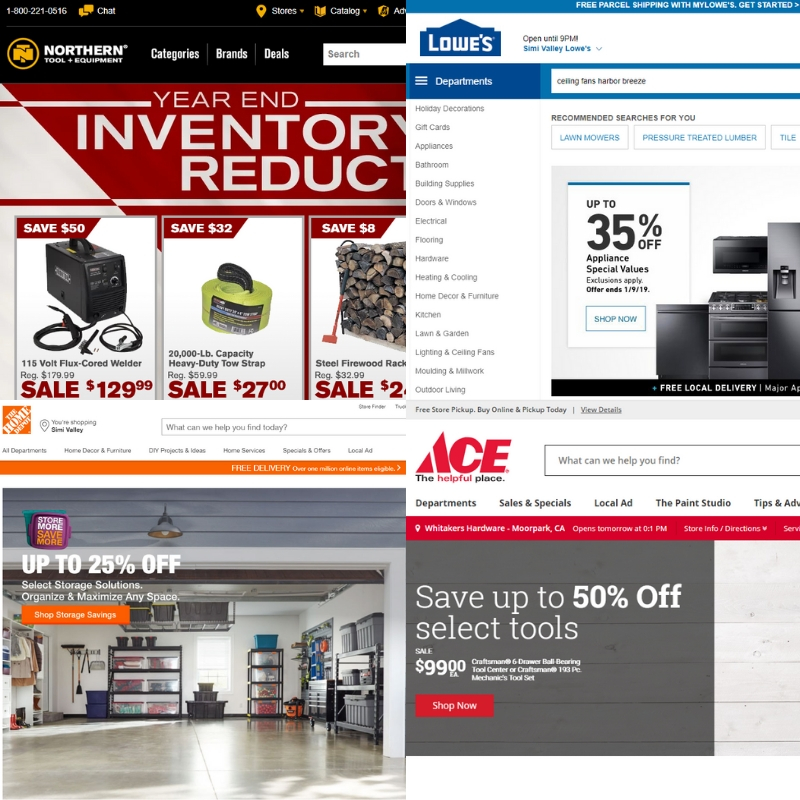
However, there’s a big difference — and the reason why I’m reviewing Harbor Freight Tools in this article.
Unlike the other retailers, Harbor Freight Tools has yet to compete in digital marketing in full force across all online channels.
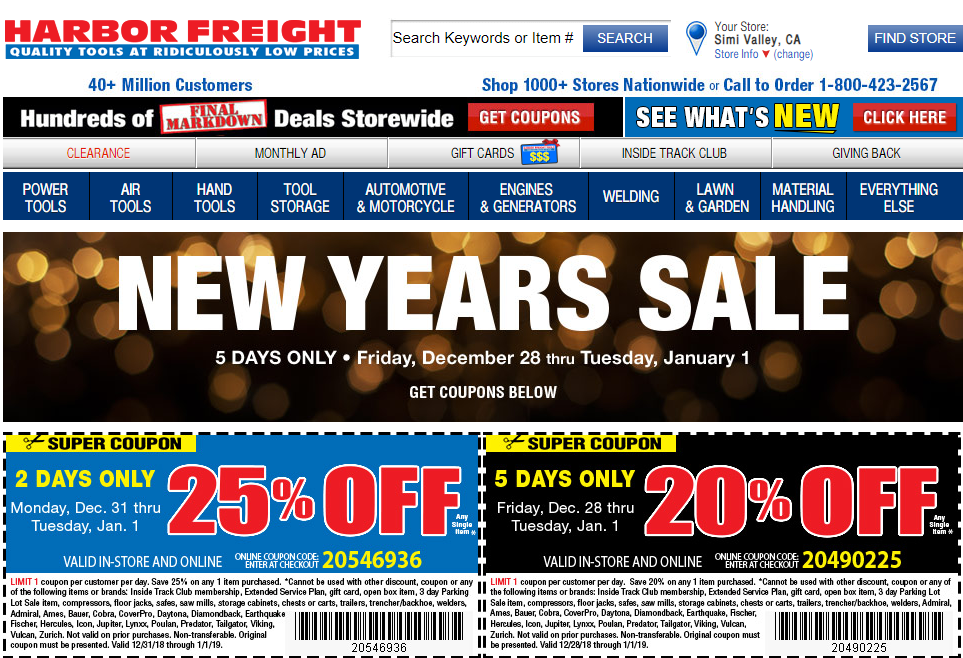
Yes, Harbor Freight is a very successful brand and business. It’s retail stores drive hundreds of millions in revenue every year.
But is anything left on the table? You bet. Especially when digital channels has not been fully leveraged. The untapped opportunity for Harbor Freight Tools is enormous.
Undoubtedly, there’s a huge opportunity to also beef up its online strategy to create a more connected and holistic customer-centric shopping experience.
I will go into detail in this article how HFT can increase it’s online sales.
But before that, here are 5 reasons why they should consider a more robust digital marketing strategy.
5 reasons why Harbor Freight Tools should engage in online marketing
There are many other reasons, but I feel these are the 5 most critical ones why HFT should add more focus to integrate internet marketing into its business operations.
1. Missing out on retargeting opportunities.
The average website conversion rate is 2% – 3%; without advanced conversion optimization. You can do the math — that means A LOT of visitors are leaving your website without buying.
Millions of online shoppers abandon retailers website every month. The reasons for leaving the website could have been because of price, bad experience, cannot find a product, or something else.
These bounced customers are taking their business somewhere else — buying from your competitor.
Retargeting (or remarketing) is a powerful tactic to put your brand in front of abandoned shoppers — your ads are only seen by people who have previously visited your website.
Retargeting is so effective because it focuses your advertising spend on people who are already familiar with your brand and have shown interest. That’s why you will see a higher ROI from a well executed retargeting campaign.
2. 80% of shoppers use mobile devices.
One of the most popular social influencer of our time, Gary Vaynerchuck, admits that he doesn’t even work from a desktop or laptop anymore. His device of choice – the smartphone.
Whether you like it or not, mobile is here to stay. Having a mobile-first strategy for an online business make sense to remain competitive in the next 2 to 5 years.

According to Statista, mobile ecommerce sales will exceed 3.5 trillion dollars by 2021. This presents a huge opportunity to shift some serious resources to create an amazing mobile experience for your customers.
3. Measurable spend and trackable ROI.
The return on advertising and marketing dollars should be tracked and accounted for.
Unlike print ads or traditional catalog advertising, digital marketing is measurable because the campaigns can be segmented to target specific audiences.
Online spending costs that can be measured to a ROI will provide the business with more insights and guidance on where to invest more to drive steady growth for the business.
4. A/B testing to refine customer experience.
Consider this scenario.
You want to test selling a product online. You’re not sure if it will generate incremental revenue for the business. So what can you do?
With online marketing, you can launch a test. Show one version to 50% of your website visitors and another version to the other 50%.
For example: let’s look at the 3 ton Low Profile Steel Heavy Duty Floor Jack with Rapid Pump®
This product is available to purchase in store only.
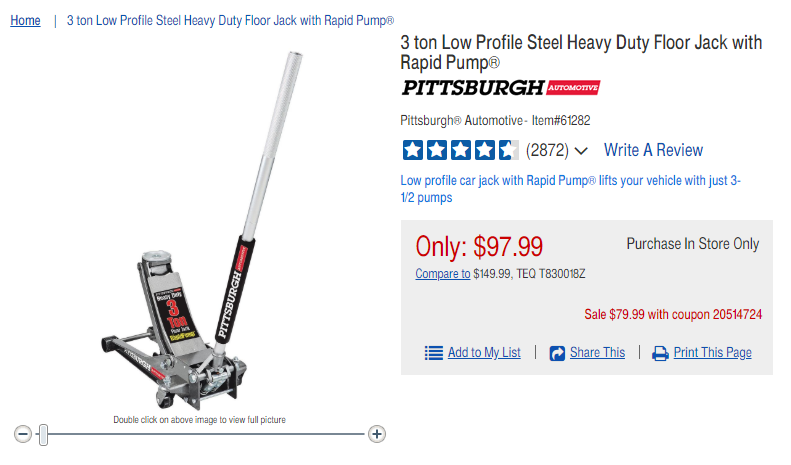
What if Harbor Freight allowed people to buy it online. Maybe even add the option to pick it up at the store?
Why would they do that?
Because it captures the customer when they are expressing an intent to buy, reduce customer friction (imagine the customer driving to the store to find out its not in stock!), and creates a seamless buying experience.
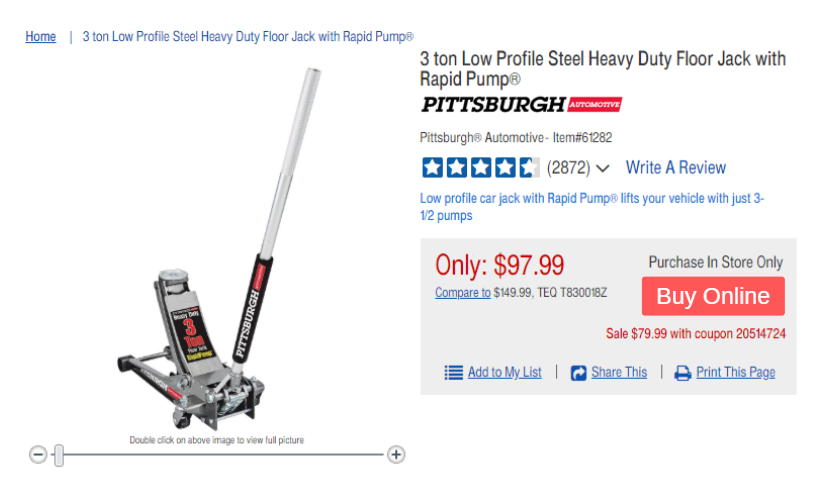
From my experience in running several tests for eCommerce clients, I am wiling to bet this change will increase their online sales without cannibalizing store sales.
With print ads, it is practically impossible to create multiple versions of the advertisement and gather instant customer feedback. In fact, you won’t even know the impact of a print ad until weeks later.
A/B testing allows you to test the effectiveness of any component — color of buttons, location of email sign up CTA, subject lines, words used in promotional banners, etc — and gather the results quicker than ever.
5. Local tactics to out perform the competition.
With 1,000+ stores nationwide, it is important for Harbor Freight to implement online tactics to drive more foot traffic into stores.
Why would they want to do that? It will cannibalize online sales. Right? In fact, it’s a misconception by many marketers. When online and offline strategies are orchestrated to work in harmony, a local marketing campaign can drive incremental revenue for the business.
Here’s a search I did in Google for “hardward store simi valley ca.” Even though there is a HFT store near where I live, it is not showing up in Google’s local result.
Instead, I see local competitors’ listing.
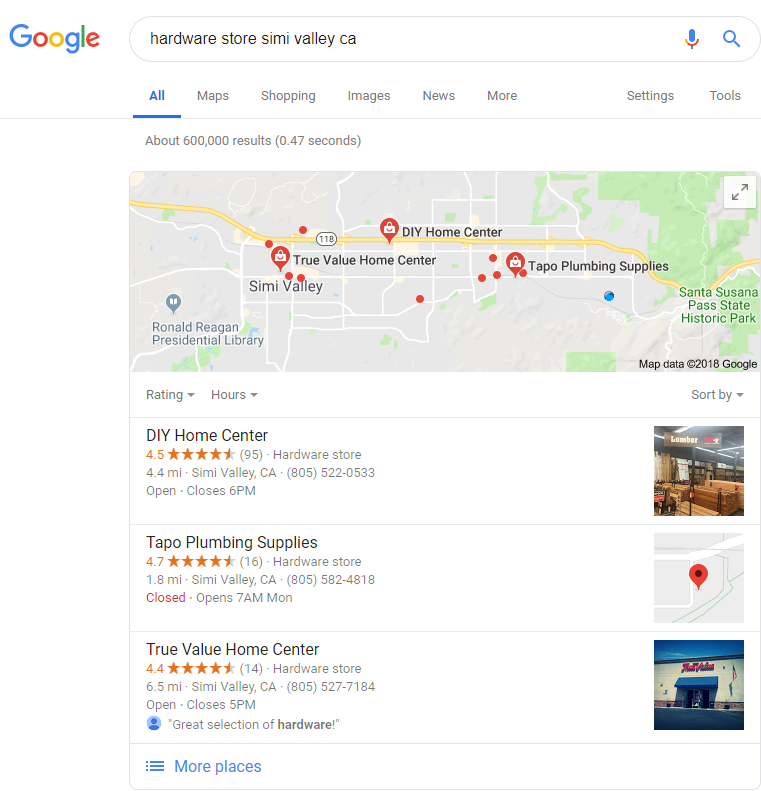
Harbor Freight is missing opportunities to put their store in front of customers who are looking — these could be contractors, homeowners, DIYers, etc — a whole new segment of new customers.
Another frequently used qualifier in searches is “near me” so I tried searching for a “hardware store near me.”
And the results were similar — HFT did not show up in the search results.
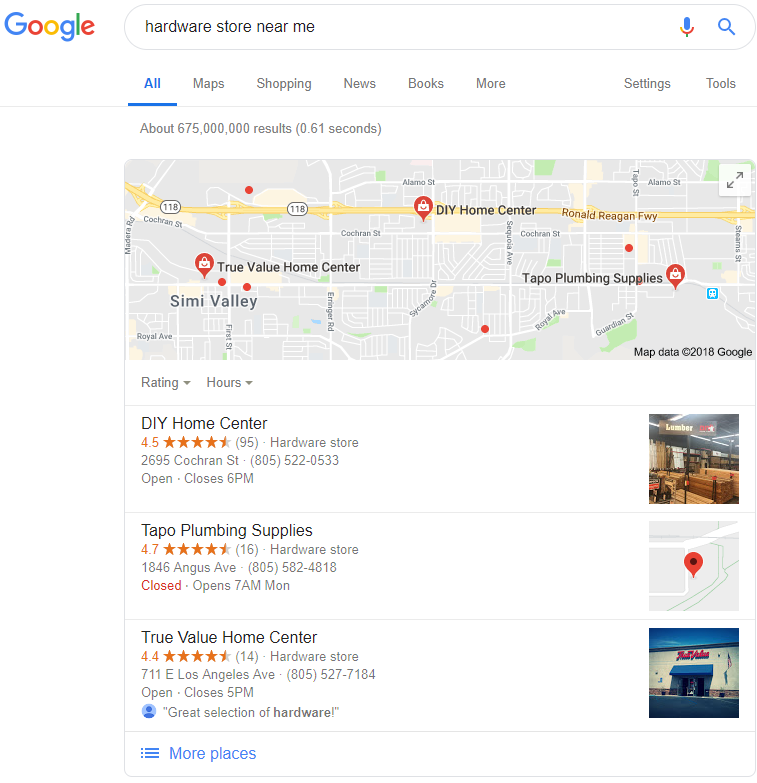
Scrolling further past the local results to the SERP listing, it gets more interesting.
Lowe’s, Home Depot and Ace Hardware have further optimized their store pages to rank in Google’s organic search results.
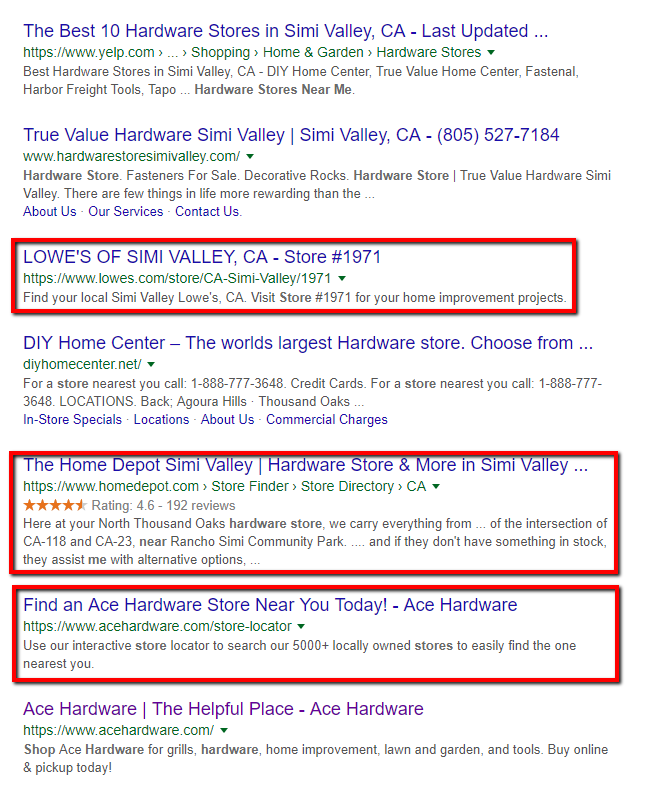
Everything I mentioned above are opportunities for Harbor Freight Tools to capture more online local market share.
By ranking in local searches, Harbor Freight will increase brand visibility, drive more traffic to the website and store, and establish wider footprint.
But there’s more
Let’s go into more detail on how HFT can drive more website traffic and sales to it’s online store.
Google Ads
Formerly known as Google AdWords, it represents 97% of Google’s total revenue.
With so much at stake, it’s no surprise of the importance of Google Ads to Google’s business.
Google Ads is one of the most effective marketing channel to put your brand and products in front of online customers.
Pay-per-click (PPC) campaigns are run by companies of all sizes in the hardware tool business. For very good reason.
For every $1 spent on Google advertising, the average business generates $2 – $3 in revenue. Most people cannot tell the difference between organic and paid search results.
Google Ads campaigns that are optimized can yield higher returns; usually in the range of 4.5X to 6X or higher depending on several other factors.
Google Ads team have done an excellent job in blending paid and organic results to look close enough to the searcher.
A few statistics why the company needs to start investing in Google Ads:
- According to Search Engine Watch, 72% of AdWords marketers plan to increase their PPC budgets.
- 70% of mobile searchers call a business directly from Google Search
- 70% of mobile searches result in action being taken within an hour.
Here’s an example of how HFT can be leveraging Google Ads to get more website traffic and get more sales.
A search for “portable air compressor” returns results in Shopping Ads, which I’ll talk about next, and Google Ads right below.
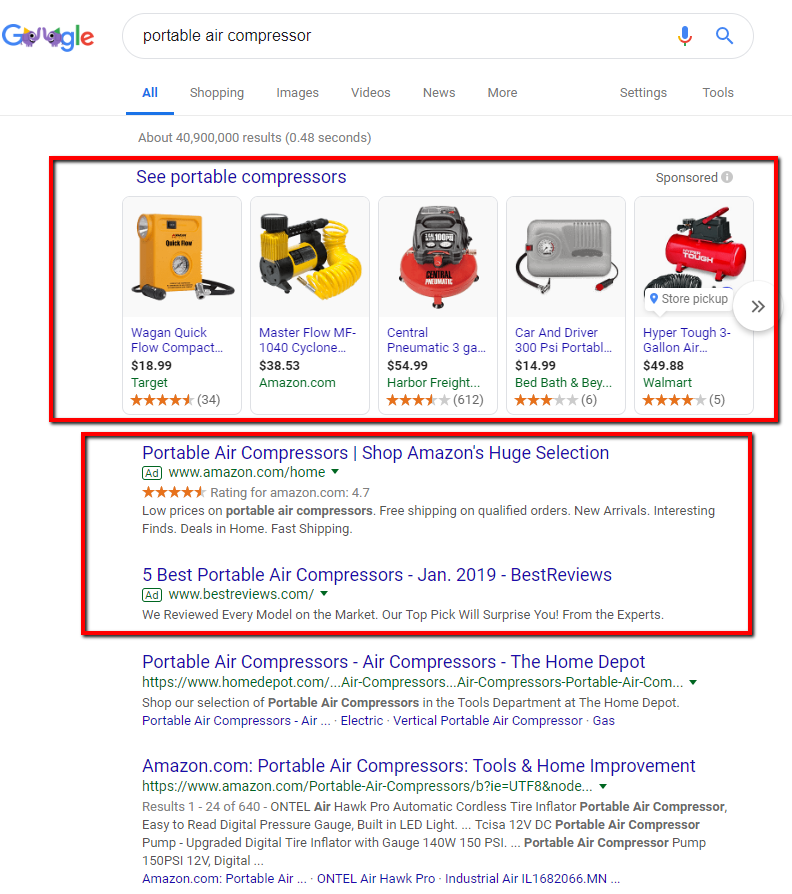
The advertisers in the results vary depending on several factors from keyword matches to bidding strategies.
The Harbor Freight website does rank in the SEO results, but it’s much further down — pushed down by the paid ads from Google Shopping and Google Ads.
Here are a few ways HFT can build out their Google Ads PPC campaign.
- Create a branded campaign — sounds simple but it serves to defend your brand from aggressive competitors who launch conquest campaigns and bid on your brand.
- Launch category campaigns for Power Tools, Air Tools, etc. These campaigns should target high level keywords to generate visibility and website traffic. Because the keyword targets don’t target the intent, conversions will be lower.
- Create campaigns for each of the sub categories if it represents a popular product group. As a general rule of thumb, if the category has enough search demand, I recommend managing it as a separate campaign.
- Otherwise, you could create these sub categories as Ad Groups under their main Category campaigns.
- Develop Single Keyword Ad Groups (SKAGs). This is a great tactic to focus on the most popular products. These are Ad Groups with only one keyword that converts really well. Why do this? It allows you precise control over how you write laser-focused ad copy to get super high CTR and conversion.
- Create campaigns based on top internal search queries. There’s nothing better than your website visitors telling you what they’re looking for via your search box.
There are more campaigns HFT can create, but the once I shared above is a great start.
It’s clear to see why bidding in Google Ads can be an effective internet marketing channel for Harbor Freight to remain competitive with it’s online competitors.
Google Ads can be set up with ease and launched without much hassle. But from my experience in managing millions of spend in Google Ads, I’ve put together some common PPC mistakes that will come in handy for the HFT team.
Shopping Ads
From my experience, Google Shopping delivers between 40% and 60% of revenue within Google Ads campaigns.
Google shopping is a pay-to-play model, when optimized can generate a healthy ROI on your advertising spend.
Here’s an example: I am interested in purchasing a backup generator for my home. So let’s search for “generators for home use” in Google.
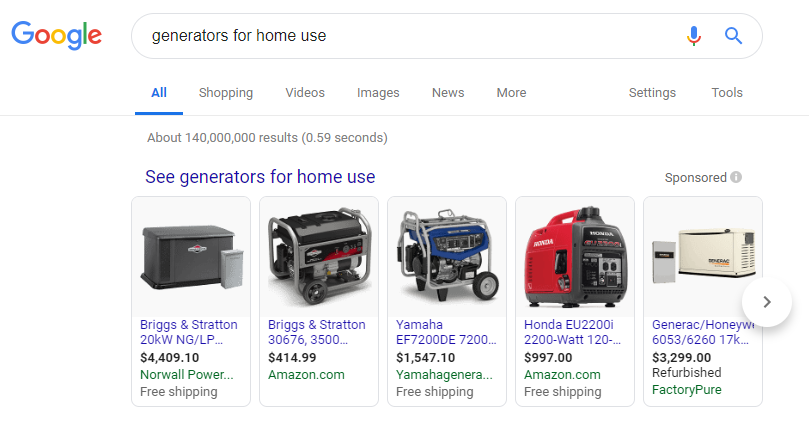
Harbor Freight is not showing in Google Shopping Ads and not putting it’s products in front of any potential shopper.
What should Harbor Freight do?
Set up a Google Merchant account, verify your website URL, and upload your optimized product data.
Google has a good step-by-step guide to create your Merchant Center account here.
“Ok Derek, this is nice but what else can I do with Google Shopping?”
Once the Google Shopping campaign is launched, there are more advanced optimization you can do to boost performance.
Other types of campaigns you can launch through Google Shopping includes Dynamic Remarketing, Customer Match, and Retargeting List for Search Ads for Shopping.
Each of these extensions will augment your Google Shopping campaign by allowing your products to reach more people with targeted and relevant product ads.
Retargeting Ads
Retargeting is one of the most powerful online marketing tactics businesses can implement to generate phenomenal ROI.
Well executed retargeting campaigns are very effective because you are putting your ads in front of people who are already familiar with your brand, have visited your website, and browsed your products.
In order to launch a retargeting campaign, audiences or customer segments must be created first.
The types of audiences you can create for your retargeting is practically limitless. How come? It is based on the behavior of your website visitors and the desired action you want them to take.
Create your audiences in Google Analytics (GA). Here’s how you do it.
Click on the Admin link located in the bottom left corner of your GA console.
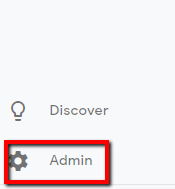
Then click on Audience Definitions.
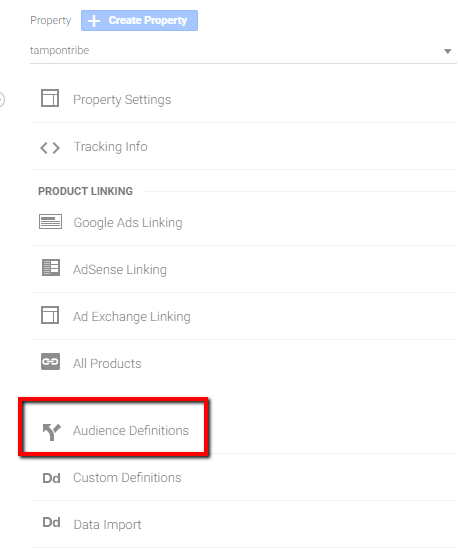
Click on Audiences.

If you have enabled Google Remarketing, then you’ll see the +NEW AUDIENCE button. If not, Google will prompt you to enable retargeting, do that.

Now you can start defining your audience.
Here are a few common audiences you should start with:
- website visitors who visited specific categories
- added products to cart
- abandoned their purchase
- repeat customers
- new customers
- high value cart abandons
- high value checkout abandons
There are several predefined audiences in GA you can start with, but those are very basic.
To create a new audience, click Create New.
In the Audience name field, I recommend you be as specific as possible to make it easier when you are launching your Google Remarketing ads.
If your audience are shopping cart abandoners, then name your audience “Shopping cart abandoners” – this is not the place to be creative or you may end up targeting the incorrect audience.
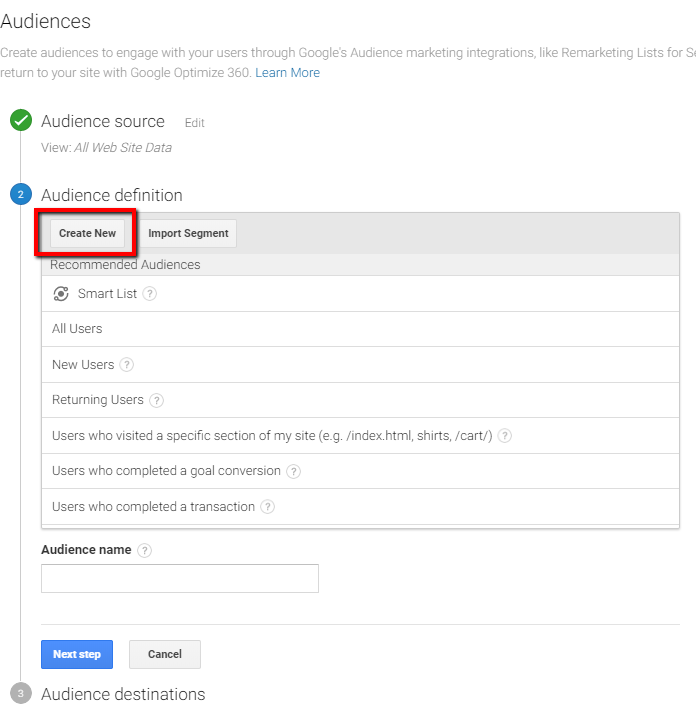
We want to build an audience of website visitors who have visited the checkout page of your website.
“But Derek, how do we know they have a product in their cart and wanted to checkout?” Reasonable question.
For most shopping cart customer flow, a typical shopper will have no reason to click all the way to the checkout page unless they’ve already demonstrated an intent to buy from you.
So to create an audience of visitors who have reached your checkout page, you will need to do 3 things.
- Click on Conditions.
- Select Page in the drop down.
- Enter the URL of your checkout page. Google will auto-suggest the URL of your checkout page once you start typing.
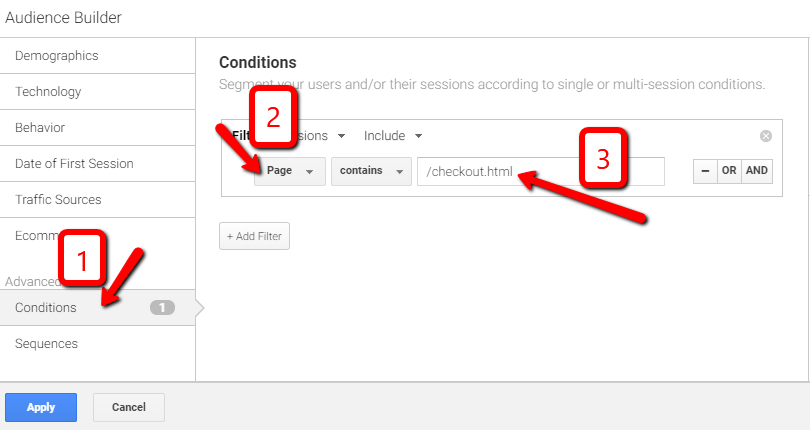
Once you have this completed, click Apply so the audience will be created on the next page based on these conditions.
Proceed to save the audience so you can apply it to your Google Ads campaign.
The power of audience targeting in PPC
There’s greater power when you layer keywords targeting with defined intent data.
Audience-focused campaigns can yield high ROI when you shape your paid search retargeting tactics around the story your website visitor data is telling you.
Conclusion
It is clear that the HFT website has a huge potential to leverage Google Ads as the company increases its online footprint.
The opportunity to serve the online shoppers is becoming increasingly important and will only grow more paramount to the success of a brand in the coming years.
Clearly, this is based on my personal opinion and what I’m seeing on the HFT website.
Without a doubt there are many more ways Harbor Freight can dominate online, this was focused on Google Ads and the immediate action the business can take to drive more sales online.
I will be reviewing more businesses in the near future. This is helpful not only to you, my readers, but hopefully shed light on the opportunities that are being left on the table by the websites reviewed.
Would love to hear your thoughts in the comments.

